Posts Tagged ‘College of Medicine and Life Sciences’
UToledo study identifies first potential biomarker for POTS, a rare condition that causes rapid heartbeat and potential fainting
Monday, September 9th, 2019New research from The University of Toledo College of Medicine and Life Sciences strongly suggests postural orthostatic tachycardia syndrome, or POTS, is an autoimmune disorder and may help pave the way for a simple blood test that could help physicians diagnose the condition.
POTS is characterized by large increases in heart rate and sometimes decreases in blood pressure when standing up. That can cause lightheadedness, heart palpitations and even loss of consciousness. In addition to fainting, POTS patients also regularly suffer from a litany of additional symptoms, including fatigue, pain, gastrointestinal issues, bleeding disorders, anxiety and brain fog.
About 3 million Americans are believed to be affected, but because of its wide-ranging and seemingly unrelated symptoms, POTS is notoriously difficult to identify.
“The trouble with diagnosing POTS is that it’s currently principally a clinical diagnosis. It’s based on history, the absence of other illness as well as the finding of increase in heart rate when standing. There is no blood test right now to aid in the diagnosis. It can be an incredibly frustrating process for patients,” said Dr. Blair Grubb, Distinguished University Professor of Medicine and Pediatrics in the UToledo College of Medicine and Life Sciences and director of electrophysiology services at The University of Toledo Medical Center.
In the largest study of POTS patients to date, published Monday, Sept. 9, in the Journal of the American Heart Association, Grubb and UToledo research collaborators found 89 percent of patients they examined had elevated levels of autoantibodies against the adrenergic alpha 1 receptor.
“People have suspected an autoimmune connection for years, and other small-scale studies have suggested it,” said Grubb, one of the world’s foremost experts in syncope and disorders of the autonomic nervous system. “We did a much larger cross-section of patients than has ever been done before, and found that almost all of them tested positive for autoimmune antibodies. That’s a significant finding.”
None of the 55 patients who participated in the study had another recognized autoimmune disorder. Fifty-two were female, with an average age of 30.
Researchers screened the patients’ blood for autoantibodies against nine receptors. A handful of patients showed elevated levels against all nine. But it was the prevalence of adrenergic A1 subtype receptor autoantibodies that make their findings so intriguing.
“I think that we have identified a biomarker. We now might have the ability to diagnosis this, or at least have an inkling. Like other autoimmune disease, we can take a blood sample and detect if there are increased levels of autoantibodies present. According to our results, autoantibodies against this particular receptor should be present in about 90 percent of patients with POTS,” said Dr. William Gunning, a professor of pathology in the UToledo College of Medicine and Life Sciences, and the paper’s lead author.
Gunning and Grubb say much more research is needed. However, this study adds significantly to the evidence that POTS is an autoimmune disorder — and it shows it may be possible to give physicians unfamiliar with the condition an easy way to test for it.
“What this does is prove the concept,” Grubb said. “Other studies had used very expensive research tests. What we used are the same kind of testing methods that would be used by regular hospitals. We wanted to do something that would potentially be a test applicable to the general population, not just a research test.”
While Gunning and Grubb caution they’re still investigating the precise methods by which POTS is established, their study does raise the possibility that existing immune modulating medications could be a viable therapeutic method for some patients.
The study was supported by funding from the Dysautonomia Advocacy Foundation, the Life as a Zebra Foundation, and the Virginia Lounsbury Foundation.
Physician who explored space to give College of Medicine and Life Sciences commencement address May 10
Monday, May 6th, 2019Dr. Scott Parazynski, a pioneering explorer, inventor, astronaut and physician, will deliver the commencement address at The University of Toledo College of Medicine and Life Sciences’ graduation ceremony Friday, May 10.
A total of 238 degrees will be awarded: 166 doctor of medicine degrees, nine doctor of philosophy degrees, 59 master’s degrees, and four graduate certificates.
The commencement ceremony will begin at 4 p.m. in Savage Arena.

Scott Parazynski
“I am beyond thrilled to come celebrate this great milestone with the healers of the @UToledoMed Class of 2019!” Parazynski wrote on Twitter after he was announced as the commencement speaker.
Parazynski, who earned a medical degree at Stanford Medical School, can easily lay claim to being one of history’s most well-traveled explorers.
He has ascended Mount Everest, spent more than eight weeks orbiting the Earth and more than 47 hours on spacewalks with NASA, visited Antarctica, and conducted scientific research beneath the surface of one of the globe’s highest lakes in Chile.
Parazynski also served as the personal onboard physician for the late John Glenn when the former senator returned to space in 1998, and has founded multiple research and development companies.
“It is an honor to have Dr. Parazynski address our graduates,” said Dr. Christopher Cooper, dean of the College of Medicine and Life Sciences, and executive vice president for clinical affairs. “Dr. Parazynski was selected by a committee of medical students and faculty from a national pool in recognition of his extraordinary accomplishments both professionally and through personal explorations.”
The College of Medicine will award Parazynski an honorary doctor of science.
One of Parazynski’s current projects is with Fluidity Technologies, a company he founded to focus on developing disruptive control devices for everything from drones to surgical robots
Accreditation restored to UToledo’s Physician Assistant Program
Thursday, April 11th, 2019The University of Toledo’s Physician Assistant Studies Program has been granted full accreditation in recognition of the high-quality education provided to students in a program that meets or exceeds national standards.
The Accreditation Review Commission on Education for the Physician Assistant (ARC-PA) notified the University in a letter sent April 11 that its accreditation has been restored. The program is now on accreditation-continued status, which is in effect until its next review in September 2027. The program had been on accreditation-probation status.
“We are proud ARC-PA recognized our efforts to enhance the quality of our PA program and continually improve on our processes and procedures,” said Dr. Christopher Cooper, dean of the College of Medicine and Life Sciences. “We have remained committed to our students in the program throughout this process and are happy to share this positive outcome with them.”
“We are pleased with this outcome and I want to thank the leadership from the College of Medicine and Life Sciences, College of Graduate Studies and the Provost’s Office for their efforts to develop and implement an action plan focused on enriching the academic experience for the students in our Physician Assistant Studies Program,” UToledo President Sharon L. Gaber said.
The University’s accreditation status is:
The Accreditation Review Commission on Education for the Physician Assistant, Inc. (ARC-PA) has granted Accreditation-Continued status to the University of Toledo Physician Assistant Program sponsored by the University of Toledo. Accreditation-Continued is an accreditation status granted when a currently accredited program is in compliance with the ARCPA Standards.
Accreditation remains in effect until the program closes or withdraws from the accreditation process or until accreditation is withdrawn for failure to comply with the Standards. The approximate date for the next validation review of the program by the ARC-PA will be 2027 September. The review date is contingent upon continued compliance with the Accreditation Standards and ARC-PA policy.
UToledo medical students to learn residency placements at Match Day event
Monday, March 11th, 2019More than 150 fourth-year medical students at The University of Toledo will learn on Friday, March 15, where they will carry out their residencies on the way to becoming attending physicians.
The annual Match Day event is a highly anticipated ceremony for graduating medical students across the country. At precisely noon, UToledo College of Medicine and Life Sciences students will join thousands of students from other medical schools across the country in tearing open envelopes that contain their match.
“Match Day is very exciting for our students and the faculty and staff who support them,” said Dr. Christopher Cooper, dean of the College of Medicine and Life Sciences. “It is the culmination of four years of intense training and now the graduating seniors find out where their next phase of residency training will occur.”
The 2019 Residency Match Reception will begin at 11 a.m. at the Stranahan Theater’s Great Hall. The event is by invitation-only.
Medical students spend months interviewing with hospitals and universities across the country to determine where they want to spend the next three to seven years of their medical training.
Students rank their top institutions, and academic and community-based health systems rank their top student choices. A computer algorithm administered by the National Resident Matching Program then matches students and residency programs together.
Residents are licensed physicians who care for patients under the supervision of attending physicians while they continue to train in their chosen specialty.
Last year, 157 UToledo fourth-year medical students matched into positions in 23 medical specialties.
UT to develop training tool to better care for patients who are homeless
Wednesday, February 13th, 2019The University of Toledo is developing a virtual reality training to improve Ohio Medicaid providers’ cultural competency and reduce implicit bias as a way to better understand the patients they serve. The virtual reality training focuses on the barriers to health care faced by those without stable, permanent housing.
UT faculty from the College of Medicine and Life Sciences and the College of Health and Human Services will conduct interviews and observe interactions in an area homeless shelter to build a realistic portrait of the health-care struggles experienced by individuals who depend on urban homeless shelters for their housing.
From that data, faculty and staff from the College of Medicine and Life Science, the School of Population Health in the College of Health and Human Services and the Interprofessional Immersive Simulation Center will create an interactive experience that will electronically place clinicians into a model homeless shelter as fly-on-the-wall observers.
“There’s a lot of attention nowadays to how one’s background and social structure impact not only their health but also how successful they are in using the health-care system,” said Dr. Lance Dworkin, chair of UT’s Department of Medicine and the primary investigator for the project. “If we understand that, we can integrate that knowledge into the care we provide so it’s more effective.”
The University also is building a robust evaluation component into the program that will monitor physical biomarkers such as heart rate, blood pressure and respiratory rate while participants are engaged in the simulation. Using assessment software developed by Dr. Scott Pappada, assistant professor of anesthesiology and bioengineering, and a co-investigator on the project, researchers will collect data before and after the simulation to learn how the program affects clinicians and whether it helps them connect with individuals who are marginalized by society.
The project is funded by a $1.24 million grant from the Ohio Department of Medicaid.
UT’s work is part of a larger partnership between the Ohio Department of Medicaid and Ohio’s medical schools, administered by the Ohio Colleges of Medicine Government Resource Center. Like many projects managed by GRC, the Medicaid Equity Simulation project is aimed at reducing health disparities, addressing the social determinants of health and improving patient care and health outcomes for Ohio’s Medicaid population.
Over the course of the homeless shelter simulation, health-care providers will see rudimentary sleeping quarters, dining and social areas, observe the interactions between guests and staff and listen in on conversations gleaned from the real-life interviews.
“The big message here is how does one change clinical decision making based on what is learned about an individual in this environment,” said Dr. Shipra Singh, assistant professor of health education and public health and a co-investigator on the project.
Singh, who is directing the scripts that will be used in the simulation, said those changes could be as simple as not forcing someone who has no access to reliable transportation to go to the back of the line if they’re late for an appointment, or understanding that immediate lifestyle changes may not be possible.
“You need to listen to the patient rather than just look at them, and understand the cultural context they’re coming from and what really matters to them,” Singh said.
The program is expected to be ready to launch to Ohio Medicaid providers within The University of Toledo Medical Center in May and disseminated throughout the community by June.
A new mouse model from UT may unlock the secrets of treating Type I diabetes
Tuesday, February 12th, 2019Researchers at The University of Toledo have found a new way to replicate in lab mice the development and progression of Type I diabetes, a breakthrough that has the potential to reshape how the chronic disease is studied.
An estimated 1.25 million Americans are living with Type I diabetes. While the condition can be managed with insulin, finding a treatment or cure for the disease has been elusive — in part because scientists have not had a reliable animal model that mimics the full scope of human Type I diabetes.
“We see these patients every day. We see them come to the hospital, we see how they struggle,” said Dr. Juan Jaume, professor of medicine in UT’s College of Medicine and Life Sciences and senior author of the new invention. “Unfortunately, research has been held back because the scientific community didn’t have a good model to study the disease and its progression. Now we do. We have developed a mouse model that is a step forward toward finding a cure.”
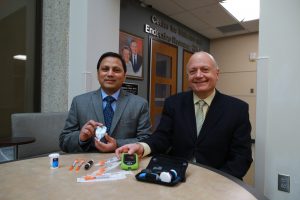
Dr. Shahnawaz Imam, left, and Dr. Juan Jaume display an array of diabetes management tools. A new mouse model developed at the University of Toledo may open the door to research that finds new therapies.
The first peer-reviewed study using the UT-developed mouse model was published Feb. 7 in the natural sciences journal Scientific Reports.
In that study, Jaume, who is also chief of the Division of Endocrinology and director of UT’s Center for Diabetes and Endocrine Research, and co-collaborator Dr. Shahnawaz Imam, a senior researcher in the Departments of Medicine and an associate member of the Center for Diabetes and Endocrine Research, looked at how a certain protein can influence T-cells in the pancreas to delay the onset of diabetes.
While the study adds to the overall knowledge about diabetes, it is the mouse model that holds the real potential.
In the new model, mice spontaneously develop Type I diabetes and, importantly, the full range of complications experienced by diabetes patients. That allows study of the disease and its natural progression in a way not previously possible.
“Our model is showing exactly the same physiopathology that humans with diabetes suffer,” Imam said. “Our mice are getting eye problems, they are getting kidney problems and also neuropathy. That’s a very important part of this — they have the same human complications that all diabetes patients have, not just those with Type I.”
The laboratory mice were developed through a series of selective breeding experiments and genetic modification that included adding human genes to the mice.
A provisional patent on the Spontaneous Type I Diabetes Mouse Model was filed last year.
Type I diabetes, formerly known as juvenile diabetes, results from an autoimmune attack on cells in the pancreas that produce insulin. Without insulin, the body cannot process the sugars in food, leading to dangerously high blood sugar.
Though many species develop diabetes, Jaume said the process of Type I diabetes seems to be unique to humans. And while scientists have frequently used other specially bred mice, including what’s known as the non-obese diabetic mouse, to study diabetes and test treatments, those lab animals don’t mimic the exact human pathophysiology of the disease.
“The existing non-obese diabetic mouse model does not completely resemble the human condition,” Jaume said. “There are more than 125 different therapies that cure Type I diabetes in non-obese diabetic mice. Clinical trials were developed because of that model, but none have worked in humans. Everybody has been searching for a better model.”
Jaume and Imam have been working on their model for more than a decade. It is already showing research promise.
Using the same idea behind CAR T-cell therapy for cancer, in which certain immune system cells are taken from a patient and paired with an artificial receptor that once reintroduced into the body homes in on the tumor, the team is developing cellular therapies for diabetes that uses the mice’s regulatory cells to cool down the immune response.
The University has also filed a provisional patent on the treatment method, and Jaume and Imam will soon begin a more in-depth study of its effectiveness.
UT research finds link between refined dietary fiber, gut bacteria and liver cancer
Thursday, October 18th, 2018Many of the processed foods we find on grocery store shelves have been loaded up with highly refined soluble fibers such as inulin, a popular probiotic that recently received approval from the Food and Drug Administration to be marketed as health-promoting.
But a new study from The University of Toledo’s College of Medicine and Life Sciences is raising serious questions about whether the risks of adding refined fiber to processed foods may significantly outweigh the benefits.
Dr. Matam Vijay-Kumar, director of the UT Microbiome Consortium and associate professor in the UT Department of Physiology and Pharmacology, and his research team recently investigated if a diet enriched with refined inulin might help combat obesity-associated complications in mice.
While the inulin-containing diet did stave off obesity in 40 percent of mice, many of those same mice went on to develop liver cancer at the end of the six-month study.
“The findings shook us,” Vijay-Kumar said, “but at the same time we recognized their potential importance and accepted the challenge of exploring how processed dietary soluble fiber was inducing liver cancer.”
Although this study was performed in mice, it has potential implications for human health. It also suggests, researchers say, that enriching processed foods with refined, fermentable fiber should be approached with great caution.
“We fully appreciate that the fibers present in whole foods like fruits and vegetables are healthy,” Vijay-Kumar said. “Because of that, fortifying or adding purified fiber to processed food sounds logical. However, our results suggest it may in fact be dangerous.”
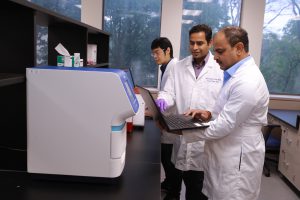
Dr. Vishal Singh, center, a Crohn’s and Colitis Foundation Fellow at The University of Toledo, recently authored a study published in the journal Cell that found a link between highly refined soluble fibers and liver cancer. He is pictured with fellow researchers Beng San Yeoh, left, a PhD student, and Dr. Matam Vijay-Kumar, right, director of the UT Microbiome Consortium and associate professor in the UT Department of Physiology and Pharmacology.
The findings were published in the Oct. 18 issue of Cell, one of the world’s leading biological journals.
There are two basic types of naturally occurring dietary fiber, soluble and insoluble. Soluble fibers are fermented by gut bacteria into short-chain fatty acids. Insoluble fibers pass through the digestive system unchanged.
While both types are beneficial, the concern raised in the study relates to how gut bacteria break down the highly refined fiber that is added to some processed foods as a dietary supplement.
Dr. Vishal Singh, a Crohn’s and Colitis Foundation Fellow at The University of Toledo and lead author of the paper, said refined fiber is a new addition to our diets and that we are in the very early stages of understanding the risks and benefits it may present.
“Soluble fibers added to processed foods are not part of a natural meal,” Singh said. “The inulin used in this study is from chicory root, which is not a food we would normally eat. In addition, during the extraction and processing of the fiber, it goes through a chemical process. We don’t know how the body responds to these processed fibers.”
Chicory root is used as a source of inulin to fortify fiber in processed foods.
The mice that developed liver cancer in this study had altered and elevated gut bacteria, a condition known as dysbiosis. Intriguingly, the researchers observed no evidence of liver cancer in inulin-fed mice that were treated with broad-spectrum antibiotics to deplete gut bacteria.
The UT researchers collaborated with researchers at Georgia State University who performed a similar study in germ-free mice that completely lack gut bacteria. The absence of liver cancer in those mice further confirmed the contributory role of gut bacteria.
The bacteria collectively known as gut microbiota degrade and digest soluble fibers via fermentation. To inhibit that fermentation process, the UT researchers fed mice beta acids derived from Humulus lupulus — a plant more commonly known for producing the hops that go into beer to prevent spoilage from fermentation.
“Strikingly, feeding beta-acids to inulin-fed mice averted liver cancer, which further reinforces our hypothesis that gut bacterial dysmetabolism primarily driving liver cancer in these mice,” Singh said.
Researchers also found they could halt the development of liver cancer by intervening to replace inulin with the insoluble fiber cellulose.
“Cellulose could not be fermented by gut bacteria present in mice or humans. This finding again highlights the link between bacterial fermentation of soluble fiber and liver cancer development in these mice,” said Beng San Yeoh, a graduate student in Vijay-Kumar’s lab and another lead author of the study.
Researchers say their findings suggest the need for more studies that look at human consumption of the type of refined fiber found in processed foods.
“Our study is going against the conventional wisdom of what people think, that fiber is good, no matter how they get it,” Vijay-Kumar said. “We do not want to promote that fiber is bad. Rather, we highlight that fortifying processed foods with refined soluble fiber may not be safe or advisable to certain individuals with gut bacterial overgrowth or dysbiosis, whose abnormal fermentation of this fiber could increase the susceptibly to liver cancer.”
The study was supported by the National Cancer Institute of the National Institutes of Health.
A no-pain gain to fight hypertension: UT research finds way to mimic exercise’s blood pressure lowering effects
Tuesday, October 16th, 2018Couch potatoes rejoice — there might be a way to get the blood pressure lowering benefits of exercise in pill form.
Hypertension researchers at The University of Toledo have shown that by increasing the body’s supply of beta hydroxybutyrate, a chemical produced predominantly by the liver, it is possible to regulate high blood pressure without reducing sodium intake or increasing exercise.
“Our team found that high salt consumption lowered levels of circulating beta hydroxybutyrate. When we put beta hydroxybutyrate back in the system, normal blood pressure is restored,” said Dr. Bina Joe, Distinguished University Professor and chair of UT’s Department of Physiology and Pharmacology and director of the Center for Hypertension and Precision Medicine. “We have an opportunity to control salt-sensitive hypertension without exercising.”
The team’s findings were published Tuesday in the Oct. 16 issue of the life sciences journal Cell Reports.
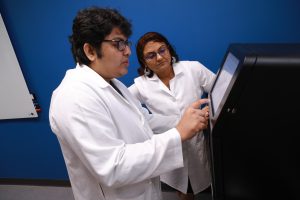
Saroj Chakraborty, a fourth-year Ph.D. student at the University of Toledo, left, and Dr. Bina Joe, Distinguished University Professor and chair of UT’s Department of Physiology and Pharmacology.
Beta hydroxybutyrate is a ketone body produced in the liver from the metabolism of fatty acids. It had not been previously explored as a method for controlling blood pressure, but the UT researchers noted a number of intriguing connections between how the body produces beta hydroxybutyrate and environmental factors known to raise or lower blood pressure.
“As we searched through the literature we saw beta hydroxybutyrate has been observed increasing with exercise or calorie restriction. Both of those activities also reduce blood pressure. The key piece of our discovery is we now know that beta hydroxybutyrate decreases with salt consumption. This is a novel mechanism by which salt is tied to an increase in blood pressure,” said Saroj Chakraborty, a fourth-year PhD student in the UT Department of Physiology and Pharmacology and the paper’s lead author.
To test its hypothesis, the team led by Chakraborty and Joe developed a study in which they fed lab rats a chemical called 1,3-butanediol.
When that supplement reaches the liver, enzymes convert it to beta hydroxybutyrate. From there, it goes to the kidney where it was shown to reduce inflammation commonly associated with hypertension — and significantly decrease blood pressure in the process.
“By fixing the kidney it is indirectly contributing to the lowering of blood pressure. There could be many other organs that it is impacting,” Joe said. “We are studying the heart, blood vessels, brain and other organ systems. But this paper says that this molecule, predominately made in the liver, goes to the kidney, fixes kidney damage and controls your blood pressure.”
Joe noted that controlling function of the liver to regulate blood pressure is a new concept for researchers.
UT has received a provisional patent on the concept. Researchers in Joe’s lab next want to compare the level of beta hydroxybutyrate in hypertensive patients against those without high blood pressure. Further studies also will determine how much 1,3-butanediol is needed to modulate blood pressure and whether it might cause any potential damage to other organs.
Once the team collects that data, the researchers hope to secure funding for a clinical trial.
While lowering blood pressure without hitting the gym might sound appealing to those averse to breaking a sweat, it also could prove beneficial to those who aren’t able to exercise.
“There are certain patients who are not able to exercise for various reasons. This could prove to be a legitimate alternative for those individuals,” Chakraborty said.
Global Medical Missions Hall of Fame induction ceremony set for March 17
Thursday, March 15th, 2018The University of Toledo College of Medicine and Life Science’s Global Medical Missions Hall of Fame will induct a new class of honorees Saturday, March 17.
Inductees will be recognized during a ceremony at 7:30 p.m. in Collier Building Room 1000 on UT’s Health Science Campus.
Members of the 2018 class are Dr. Diane Cappelletty, Dr. Ziya Celik and International Samaritan.
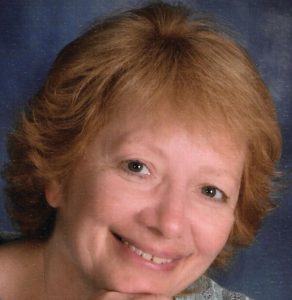
Dr. Diane Cappelletty
Cappelletty is a professor and chair of pharmacy practice in the UT College of Pharmacy and Pharmaceutical Sciences. The Monclova, Ohio, resident and UT alumna has been involved with medical missions and local medical clinics for 15 years.
Her mission work began in 2003 when she worked with a team in Peru. Since then, Cappelletty has been on numerous missions to Guatemala and Honduras, and has inspired students to serve alongside her. She compounds medications in the field, comes up with innovative techniques to provide meds during the missions, and mentors students, showing them the humanistic side of pharmacists in trying conditions. Her work has been recognized by the Ohio Society of Health System Pharmacists.
In Toledo, Cappelletty volunteers at the free Community Care Clinic, which, thanks to her efforts, was licensed by the Ohio State Board of Pharmacy.
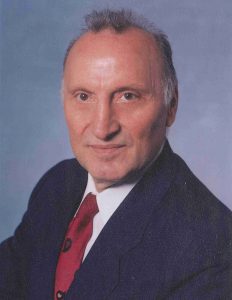
Dr. Ziya Celik
Celik is a surgeon who has participated in medical missions for more than three decades. He has worked with Midwest Medical Missions, Medishare and Medecins Sans Frontieres/Doctors Without Borders, serving in the Dominican Republic, Kenya, Haiti and Nigeria.
Born in 1941 in Rize, Turkey, Celik moved to the city of Erzurum to complete his early education. In 1960, he started medical school at the University of Istanbul, completed a surgery residency, and was an instructor at the University of Ataturk in Erzurum until 1971. In 1976, he completed a residency in general surgery at the former Medical College of Ohio.
In addition to medical missions and earthquake relief, Celik maintained a general surgery private practice in Oregon, Ohio, for 30 years, retiring in 2006. Affiliated with St. Charles Hospital, he was a 20-year member of its Executive Committee, director of surgery for 10 years and chief of staff while volunteering his surgical skills around the globe. He lives in Pompano Beach, Fla.
 International Samaritan is a ministry based in Ann Arbor, Mich., which serves more than 13,000 people each year. For nearly two decades, this nonprofit organization has established programs to alleviate severe poverty and health issues in numerous countries.
International Samaritan is a ministry based in Ann Arbor, Mich., which serves more than 13,000 people each year. For nearly two decades, this nonprofit organization has established programs to alleviate severe poverty and health issues in numerous countries.
In 1994, Rev. Donald Vettese, a Jesuit priest who was then president of St. John’s Jesuit High School in Toledo, founded this ministry after a trip with students to an orphanage in Guatemala City. In 16 years, the ministry has started programs in Guatemala, Egypt, El Salvador, Honduras, Nicaragua, Panama and Haiti. The organization also is conducting feasibility studies for similar efforts in Ethiopia, Sierra Leone and the Philippines. Oscar Dussan, president of International Samaritan, will attend the ceremony to accept the award.
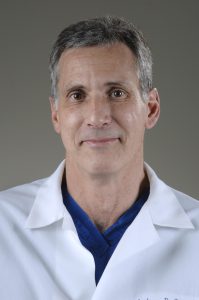
Dr. Andrew Casabianca
In addition, Dr. Andrew Casabianca, associate professor and chair of anesthesiology in the UT College of Medicine and Life Sciences and medical director of operative services at UT Medical Center, will receive the Dr. Lawrence V. Conway Lifetime Distinguished Service Award. He also is associate professor of surgery and dentistry.
Since traveling to the Dominican Republic on his first medical mission trip in 1994, Casabianca has returned every year. A member of the Midwest Medical Missions, he has participated in more than 30 trips, conducting primary care, anesthesia and dentistry. Casabianca has been the faculty adviser for UT Students for Medical Missions and is on the missions committee at Calvary Church in Maumee. He also was on the planning committee for Serve Week, participated in medical clinics for Vision Ministries and Convoy of Hope, and is a board member for Midwest Medical Missions.
RSVPs are requested for the free, public induction ceremony. Call 419.530.2586 or 1.800.235.6766, register online or email medmissionhof@utoledo.edu.
In conjunction with the induction ceremony, the College of Medicine Students for Medical Missions will host a symposium from 8:30 a.m. to 1:30 p.m. Saturday, March 17 in Health Education Building 110.
Speakers will include Cappelletty, Celik, Dussan and Casabianca. Register for the free symposium here.
Dr. Lawrence V. Conway, UT professor emeritus of finance, founded the Global Medical Missions Hall of Fame in 2004 to honor individuals and organizations that have made significant contributions to advancing the medical well-being of people around the world. In 2006, the Global Medical Missions Hall of Fame became affiliated with the UT College of Medicine and Life Sciences. The hall of fame can be seen in the lobby of the Jacobs Interprofessional Immersive Simulation Center.
UT researchers to lead 38% of Ohio’s new water quality research projects, including ‘impairment’ criteria
Wednesday, February 14th, 2018The University of Toledo is slated to lead eight out of the 21 new research projects to be funded with $3.5 million from the state of Ohio to address water quality and algal bloom toxicity.
UT, situated on the western basin of Lake Erie, is to receive nearly $1 million of the $3.5 million dedicated by the Ohio Department of Higher Education for these additional projects in the ongoing, statewide Harmful Algal Bloom Research Initiative, which began three years ago after the city of Toledo issued a Do Not Drink advisory for half a million water customers due to the level of microcystin detected in the water.
UT is one of the lead universities in the Harmful Algal Bloom Research Initiative, which consists of ten Ohio universities and five state agencies.
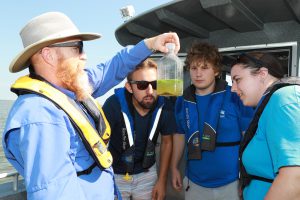 The selected projects focus on reducing nutrient loading to Lake Erie; investigating algal toxin formation and human health impacts; studying bloom dynamics; better informing water treatment plants how to remove toxin; and aiding the efforts of state agencies.
The selected projects focus on reducing nutrient loading to Lake Erie; investigating algal toxin formation and human health impacts; studying bloom dynamics; better informing water treatment plants how to remove toxin; and aiding the efforts of state agencies.
Dr. Tom Bridgeman, professor in the Department of Environmental Sciences, will lead a project to develop sampling protocols and collect samples to assess listing criteria that the Ohio Environmental Protection Agency may use to monitor the water quality of the open waters of the western basin of Lake Erie and to potentially assign official designations such as “impaired” or “unimpaired.”
“Although it is obvious to nearly everyone that harmful algal blooms are impairing Lake Erie each summer, we need to develop objective scientific criteria that can be used to list the open waters of the lake as officially ‘impaired,’ and to remove an ‘impairment’ designation in the future if conditions improve sufficiently,” Bridgeman said.
UT researchers also to receive some of the $988,829 in state funding for their projects are:
- Dr. Jason Huntley, associate professor in the Department of Medical Microbiology and Immunology, will be developing and testing biofilters – water filters containing specialized bacteria that degrade microcystin toxins from lake water as it flows through the filter. These biofilter studies are aimed to develop cost-effective, efficient and safe drinking water treatment alternatives for the city of Toledo and other Lake Erie water municipalities.
- Dr. Steven Haller and Dr. David Kennedy, assistant professors in the Department of Medicine, will investigate how cyanotoxins such as microcystin damage organs not only in healthy settings, but in settings that may increase susceptibility such as diabetes, obesity and inflammatory bowel disease. Their research teams are working in concert with experts in medicine, pathology, physiology, pharmacology and chemistry to not only to learn how microcystin affects organ function in these settings, but also to create new therapies to prevent and treat organ damage, especially in vulnerable patient populations.
- Dr. Patrick Lawrence, UT professor in the Department of Geography and Planning, will use a transportation model to simulate potential distribution of volume of agricultural manure from permitted livestock facilities to surrounding farmland for application as a nutrient. The results will assist in determining the estimated acreage of land within the Lake Erie western basin where manure application could be undertaken and examine associated crop types, farming practices, soil types, drainage and other environmental conditions in those areas.
- Dr. Saatvika Rai, assistant professor of environmental policy in the Department of Political Science and Public Administration, and Dr. Kevin Czajkowski, professor in the Department of Geography and Planning, will use GIS and remote sensing to assess the implementation of agricultural and farming practices in three sub-watersheds of the Maumee River Basin – Auglaize, Blanchard and St. Joseph – to identify where best management practices are being implemented. These maps will then be correlated with perceptions of farmers through surveys and interviews to identify hotspots and priority areas for policy intervention in the region.
- Dr. April Ames, assistant professor in the College of Health and Human Services, will apply an industrial hygiene technique to the exploration of the presence of microcystin in the air using research boats on Lake Erie. Simultaneously, residents who live on or near Lake Erie will be surveyed about their recreational use and self-reported health.
“I am proud of the work that is being done, and that researchers from our public and private higher education institutions continue to work together to address this issue,” said Ohio Department of Higher Education Chancellor John Carey. “Using the talent of Ohio’s researchers and students to solve pressing problems makes perfect sense.”
The Harmful Algal Bloom Research Initiative is funded by the Ohio Department of Higher Education with $7.1 million made available for four rounds of research funding since 2015. Matching funding from participating Ohio universities increases the total investment to almost $15.5 million for more than 50 projects, demonstrating the state’s overall commitment to solving the harmful algal bloom problem.
Water quality is a major research focus at UT. With more than $14 million in active grants underway, UT experts are studying algal blooms, invasive species such as Asian carp, and pollutants. Researchers are looking for pathways to restore our greatest natural resource for future generations to ensure our communities continue to have access to safe drinking water.
The UT Water Task Force, which is comprised of faculty and researchers in diverse fields spanning the University, serves as a resource for government officials and the public looking for expertise on investigating the causes and effects of algal blooms, the health of Lake Erie and the health of the communities depending on its water. The task force includes experts in economics, engineering, environmental sciences, business, pharmacy, law, chemistry and biochemistry, geography and planning, and medical microbiology and immunology.

